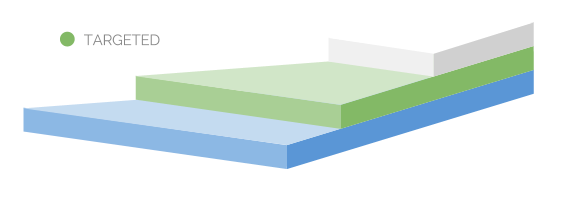Self-Determination & Self-Monitoring
|
This model teaches students how to identify the behaviors they want to exhibit, and provides a means of tracking their progress towards that. Self-determined behavior is defined as the following: “a). acting autonomously, b). engaging in self-regulated behavior, c). responding to events in a psychologically empowered manner, and d). acting in a self realizing manner” (Kelly & Shogren, 2013, p. 28).
|
This intervention can be used with any curricular subject, and has been successful with increasing on-task behaviors and decreasing off-task behaviors. When the intervention was discontinued, students were still able to maintain this improved behavior. In addition, this intervention has proven to be particularly beneficial for students with special needs, specifically with their involvement in planning for their own education, gaining access to the general education curriculum, and more positive outcomes with both employment and community involvement (Wehmeyer, 2015).
How to:
Train student in Self-Determined Learning Model of Instruction (SDLMI)
with 6-10 instructional sessions; each session is between 60-90 minutes.
Phase 1: What is my goal? (1-3 instructional sessions)
Conduct a structured conversation with the student around the following questions:
Phase 2: What is my plan? (3-6 instructional sessions)
Develop an action plan, which identifies specific daily activities necessary to meet the goal, using the following questions:
Determine when the student will monitor their behavior (for example, in 5 or 10 minute intervals or after each class/subject). Students graph results and aim for a percentage of on-task behaviors.
Phase 3: What have I learned? (1-2 instructional sessions)
Teach students to evaluate their progress towards their goals, by answering the following questions:
*(Kelly & Shogren, 2013, pp. 32- 33)
with 6-10 instructional sessions; each session is between 60-90 minutes.
Phase 1: What is my goal? (1-3 instructional sessions)
Conduct a structured conversation with the student around the following questions:
- What do I want to learn?
- What do I know about it now?
- What must change for me to learn what I don’t know?
- What can I do to make it happen?*
Phase 2: What is my plan? (3-6 instructional sessions)
Develop an action plan, which identifies specific daily activities necessary to meet the goal, using the following questions:
- Where do I start?
- What is in my way?
- How can I get these things out of my way?
- When do I start?*
Determine when the student will monitor their behavior (for example, in 5 or 10 minute intervals or after each class/subject). Students graph results and aim for a percentage of on-task behaviors.
Phase 3: What have I learned? (1-2 instructional sessions)
Teach students to evaluate their progress towards their goals, by answering the following questions:
- What actions have I taken?
- What barriers to success have I removed?
- What has changed about what I don’t know?
- Do I know what I want to know?*
*(Kelly & Shogren, 2013, pp. 32- 33)
References:
Kelly, J. R., & Shogren, K. A. (2014). The impact of teaching self-determination skills on the on-task and off-task behaviors of students with emotional and
behavioral disorders. Journal of Emotional and Behavioral Disorders, 22(1), 27-40. doi: 10.1177/1063426612470515.
Wehmeyer, M. L. (2015). Framing the future: Self-determination. Remedial and Special Education 36(1), 20-23. doi: 10.1177/0741932514551281.
Wehmeyer, M. L., Palmer, S. B., Agran, M., Mithaug, D. E., & Martin, J. E. (2000). Promoting causal agency: The self-determined learning model of
instruction. Exceptional Children, 66, 439-453.
Wehmeyer, M. L., Shogren, K. A., Palmer, S. B., WIllaims-Diehm, K. L., Little, T. D., & Boulton, A. (2012). The impact of the Self-Determined Learning Model
of Instruction on student self-determination. Exceptional Children, 78(2), 135-153.
Kelly, J. R., & Shogren, K. A. (2014). The impact of teaching self-determination skills on the on-task and off-task behaviors of students with emotional and
behavioral disorders. Journal of Emotional and Behavioral Disorders, 22(1), 27-40. doi: 10.1177/1063426612470515.
Wehmeyer, M. L. (2015). Framing the future: Self-determination. Remedial and Special Education 36(1), 20-23. doi: 10.1177/0741932514551281.
Wehmeyer, M. L., Palmer, S. B., Agran, M., Mithaug, D. E., & Martin, J. E. (2000). Promoting causal agency: The self-determined learning model of
instruction. Exceptional Children, 66, 439-453.
Wehmeyer, M. L., Shogren, K. A., Palmer, S. B., WIllaims-Diehm, K. L., Little, T. D., & Boulton, A. (2012). The impact of the Self-Determined Learning Model
of Instruction on student self-determination. Exceptional Children, 78(2), 135-153.
Resources: (NeeD LINKS)
- Goal Attainment Scaling (GAS) sheet: measures progress toward the behavioral goal, identifying a range of 5 behaviors that indicate progress in meeting the goal.
- Likert Scale or Self-Monitoring Sheets



